BC
Surrey Mounties blocking anti-vaccine mandate truck convoy at U.S. border
Updated: Surrey's 176th Street has been closed south of 8th Avenue due to a large anti-vaccine mandate protest at the U.S. border.
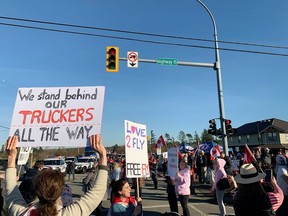
Article content
The main route to the Pacific Highway border crossing in Surrey was closed Saturday afternoon after protesters opposed to vaccine mandates and other COVID-19 measures broke through RCMP barricades and began driving the wrong way down 176th Street.
Advertisement
Article content
The RCMP says in a press release that the “behaviour is not being tolerated” and is being investigated. No arrests were made.
There were no reported injuries, but the Surrey RCMP says the drivers could have caused harm to pedestrians and first responders.
Cpl. Vanessa Munn, a spokeswoman for the Surrey RCMP, confirmed Saturday afternoon that officers continue to monitor the situation.
She said motorists should expect significant traffic congestion in the area of 176th Street and 8th Avenue and are cautioned to avoid the area. 176th Street is now closed from 8th Avenue southbound.
“Our priority remains keeping the peace and ensuring public safety,” Munn said.
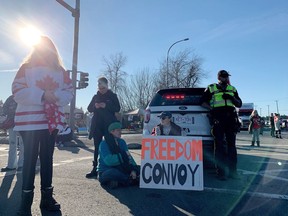
Border crossing photos show hundreds of drivers and their supporters lining the street, part of what organizers called the third Lower Mainland Freedom Convoy, which travelled from Chilliwack to the 176th Street crossing in Surrey.
Advertisement
Article content
Chris Rasmussen said he came to the rally to support freedom of choice.
“When the government mandates your decisions about your health, they’ve crossed a line,” Rasmussen said. “I’ve lost $400,000 in revenue in my companies — they’re done. Let’s get on with living.”
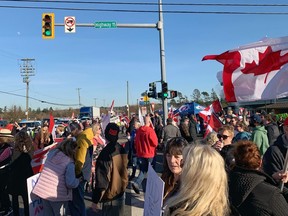
A woman named Crystal, who didn’t want to give her last name, said the Mounties shouldn’t be blocking the convoy.
“We’ve been waiting hours and hours to see the convoy,” she said, adding that the RCMP’s blockade has had the same effect as the convoy: “At the end of the day, the border’s still blocked.”
Drumming, dance music and flags filled the air at the corner of the streets. “Freedom” was periodically chanted, led by a woman with a bullhorn standing on the roof of a pickup as families with small children milled around. Chalk messages scrawled on the pavement read “freedom rules” and “media is the virus.”
Advertisement
Article content
Another woman named Kim said: “We want to make sure that our voices are heard. We want the mandates to be dropped. We want (Prime Minister Justin) Trudeau to step down from office — we want our freedoms back.”
A long line of transport trucks and other vehicles stretched down 8th Avenue on either side of the intersection.
The Surrey Board of Trade and the Surrey Chamber of Commerce both issued statements speaking out against the protesters’ actions.
“The impact of these blockades is choking already impacted supply chains, businesses and jobs,” the Board of Trade said in a statement. “This is an unacceptable sabotage of the economy.”
The Chamber of Commerce called for more action by governing bodies and said COVID-19 and extreme weather caused labour shortages and supply chain disruptions, and the protests are adding to the strain and preventing economic recovery.
“Allowing these illegal closures to continue will also have serious economic and reputational consequences for the years ahead,” it said.
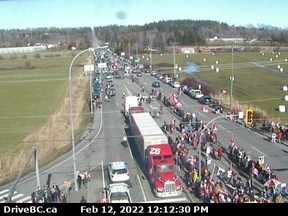
Advertisement
Article content
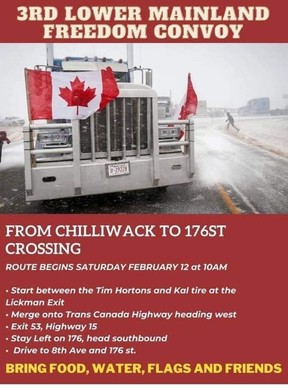
— With files from The Canadian Press
‘Freedom Convoy’ protesters, police face off at U.S.-Canada border as Trudeau looks at ‘all options’Protesters interact with police officers, who stand guard on a street after Windsor Police said that they are starting to enforce a court order to clear truckers and supporters. (REUTERS/Carlos Osorio)
By Annabelle Timsit, Bryan Pietsch and Miriam Berger
A standoff between police and protesters from the self-styled “Freedom Convoy” opposing coronavirus vaccine mandates continued Sunday near a vital U.S.-Canada border crossing, even as crowds reportedly started shrinking overnight and one arrest was made. After law enforcement enforced an injunction ordering truckers and their supporters to leave, and ticketed and towed vehicles, a defiant core of protesters mostly remained on foot as temperatures dropped below freezing.
The blockade of the Ambassador Bridge, a key trade corridor that connects Windsor, Ontario, to Detroit, which has disrupted traffic and the flow of goods since Monday, has not ended. Disruptions are still plaguing other vital cross-border arteries — from Coutts, Alberta, which connects to Montana, to Surrey, British Columbia, which connects to Washington state.
Canadian Prime Minister Justin Trudeau has stressed that “all options are on the table” to resolve the crisis, and that “border crossings cannot, and will not, remain closed,” his office said in a statement to the Associated Press.
2:52
Canadian Prime Minister Justin Trudeau on Feb. 11 promised President Biden quick action to end blockades by anti-vaccine mandate protesters at border crossings. (Reuters)
Canada and the United States have denounced the impact of border disruptions on trade, industry and local communities. Goods worth some $360 million — a quarter of the value of all goods traded between the two countries — are transported every day on Ambassador Bridge. Car manufacturers including Toyota and Ford Motor have reduced some of their nearby operations in recent days because they said the blockade disrupted the delivery of necessary manufacturing parts.
In the capital Ottawa, police grappled with an influx of anti-government and anti-vaccine-mandate demonstrators for a third straight weekend despite both local and provincial officials declaring states of emergency. Law enforcement appeared to be floundering in their attempts to get Freedom Convoy protesters to leave by threatening them with fines, prison time, and the loss of their licenses.
Ottawa’s protesters celebrate as officials declare emergencies and threaten fines
The Freedom Convoy — which began in Canada as a denunciation of vaccine mandates for cross-border truckers and has snowballed into a protest of public health measures and politicians — continued to inspire other protests around the world over the weekend.
Across the Atlantic, French protesters temporarily blocked the Champs-Élysées, a central artery in Paris on Saturday, in spite of an order banning them from entering the capital. Local outlets reported that police made at least 97 arrests.
France’s ‘Freedom Convoy’ disrupts traffic on the Champs-Elysees in Paris, confronts police
Farther afield in New Zealand’s capital, protesters inspired by the Freedom Convoy blocked an area outside parliament in Wellington for the sixth day on Sunday — as officials there attempted to use sprinklers and songs like “Baby Shark” to diffuse the protest, to no avail. Police offered to provide alternative parking arrangements for protesters so long as they move their cars and camper vans from blocking the roads.
New Zealand switches on sprinklers, and ‘Baby Shark,’ to deter ‘Freedom Convoy’-inspired protesters
In Canada, as Trudeau and police come under pressure to do more to rein in the raucous protests, some local officials have acknowledged the potentially fraught implications of mass arrests or tougher action. Windsor’s mayor, Drew Dilkens, warned that arresting people could lead to violence, saying during a news briefing last week that some protesters believe “they are fighting for a cause that is worth dying for.
Trudeau has previously said that using Canada’s military is “not in the cards right now.”
After an Ontario judge ordered the demonstrators to leave the Ambassador Bridge by 7 p.m. Friday, Windsor police tweeted Saturday evening that they were towing and ticketing vehicles there. Some vehicles began moving away from the area, while demonstrators on foot displayed the Canadian flag and sang the country’s national anthem, chanting “Freedom!” periodically. Protesters began dismantling tents at the site and packing up grilling supplies.
A wall of police officers slowly pushed protesters away from the bridge, warning that demonstrators would be arrested if they did not leave. But more people on foot had swelled the protesters’ ranks by early afternoon, with demonstrators appearing to outnumber police officers, according to reporters from the Canadian Broadcasting Corp. News, Canada’s public broadcaster.
Windsor Police said Saturday that a 27-year-old man was arrested “for a criminal offence in relation to the demonstration” at an intersection near the U.S.-Canada border. “Officers will intervene when necessary to ensure the safety of the public & maintain peace & order,” the police tweeted.

Police officers stand guard in front of a car painted with slogans as it leaves the protest, as truckers and supporters continue blocking access to the Ambassador Bridge, which connects Detroit and Windsor, in protest against coronavirus vaccine mandates, in Ontario, Canada, on February 12, 2022.
The Royal Canadian Mounted Police in Surrey, British Columbia, southeast of Vancouver, said Saturday night that there was still “significant traffic congestion” on the main road leading to the Pacific Highway Border Crossing into Blaine, Wash. The crowd was “beginning to dissipate” but there were “still a number of individuals on foot,” the police said. An incident involving “a few vehicles” crossing police barricades and driving the wrong way down a street was under investigation, the police said, noting there were no injuries.
In Nova Scotia, protesters on Saturday blocked the Marine Atlantic terminal in North Sydney — the launch point for important ferry routes to Canada’s easternmost provinces. Demonstrations also have targeted border crossings in Manitoba and Alberta, as well as Sarnia in Ontario.
Police, ‘Freedom Convoy’ protesters at stalemate near Ontario border bridge
Ontario Premier Doug Ford called the blockade a “siege” and declared a provincial state of emergency Friday, warning protesters of “severe” consequences, including fines up to $78,500 and prison terms.
In Ottawa, in continued defiance of the state of emergency, loud dance parties raged throughout the blockaded streets. As police on foot and in cars stood watch, convoys of trucks blared their horns, in-spite of anti-noise ordinances in place, and fireworks were illegally set off in crowds. Some people openly drank cans and bottles of alcohol, another violation of Ottawa law.

Demonstrators dance during a protest by truck drivers over pandemic health rules and the Trudeau government, outside the parliament of Canada in Ottawa on February 12, 2022. (Ed JONES / AFP) (Ed Jones/AFP via Getty Images)
Families with children, some just in for the day from French-speaking Quebec, mingled among the noise and fuel fumes. People marched through the street shouting “freedom” — in this environment, a catchphrase for doing whatever they wanted without personal consequence.
Hundreds of people joined a counterprotest Saturday afternoon in Ottawa, marching and chanting “Whose streets? Our streets!” and “Hey hey, ho ho, this trucker convoy has got to go!”
Meanwhile in Edmonton, the capital of Alberta province, police issued 10 tickets and said they would issue 60 more by mail as demonstrators in trucks and on foot made their way to a federal building in the city’s downtown. Some reportedly honked their horns, in defiance of a temporary injunction preventing unnecessary noise, and the police said nine of the tickets were related to noise.
Counterprotestors briefly blocked the convoy on a road leading to the Alberta Legislature, local media reported.
— Amanda Coletta in Canada, Meryl Kornfield and Claire Parker contributed to this report.
Read more:
Why are ‘Freedom Convoy’ truckers protesting in Ottawa? Our reporters answered your questions.
Canadian officials caution against ‘foreign interference’ as U.S. Republicans back ‘Freedom Convoy’ protests
Here’s what you need to know about the ‘Freedom Convoy’ in Canada‘
By Annabelle Timsit is a breaking news reporter for The Washington Post's London hub, covering news as it unfolds in the United States and around the world during the early morning hours in Washington. Twitter

By Bryan Pietschis a reporter covering breaking news for The Washington Post from its hub in Seoul. He previously covered breaking news for the New York Times in Colorado. Twitter

By Miriam Berger is a staff writer reporting on foreign news for The Washington Post from Washington, D.C. Before joining The Post in 2019 she was based in Jerusalem and Cairo and freelance reported around the Middle East, as well as parts of Africa and Central Asia. Twitter
Feb. 12, 2022
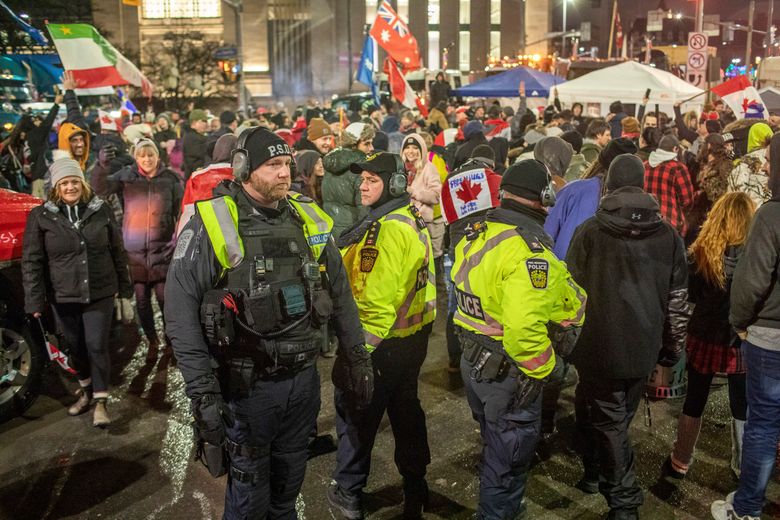
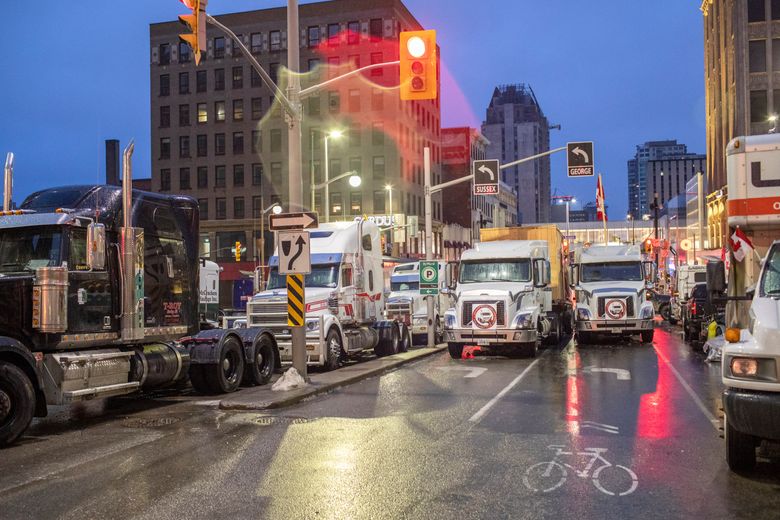
1 of 37 | Police officers watching a protest in Ottawa on Friday. They were often swarmed when trying to make arrests. (Brett Gundlock/The New York Times)
Skip Ad
By CATHERINE PORTER
The New York Times
OTTAWA, Ontario — Steps from Canada’s Parliament buildings, a sprawling festival erupted Saturday. DJs played music for crowds dancing at intersections, singers belted out songs from an improvised stage and protesters’ trucks still blocked the streets, blowing their horns to cheers.
A day after the premier of Ontario declared a state of emergency across the province and said that anyone involved in the protest would face “severe” consequences, including nearly $100,000 fines or even jail time, nothing had changed on the streets of Canada’s capital.
The few police in sight were quickly swallowed up in overwhelming crowds of people, both protesting government pandemic regulations and enjoying the party atmosphere after almost two years of intermittent lockdowns.
“They don’t have an easy job,” said Scott Spenser, 36, looking up from a drum concert on Sparks Street, as a phalanx of six officers marched by. “Hopefully, this all ends peacefully and they lift the mandates and we all get back to living.”
Throughout the day, Canadian police sought to clear many of the trucks blocking the Ambassador Bridge, a vital crossing in Windsor, Ontario, connecting the United States and Canada. But there were still a few holdouts, and traffic remained blocked for a fifth straight day.
And in Ottawa, police were still hanging back, circulating in small numbers and not visibly handing out tickets or making arrests.
Two weeks after downtown Ottawa was transformed into a raging tailgate party, many in Canada wonder how this happened — why the police seemingly abandoned the country’s seat of power, with no perceivable backup, and how a motley group of truckers, anti-government activists, anti-vaccine agitators and people just fed up after two years of stringent public health restrictions have managed not only to outfox them but also to become increasingly entrenched and to spread elsewhere.
“This is Jan. 6 in slow motion,” said Catherine McKenney, an Ottawa city councilor, who uses the pronouns they/them, referring to the Jan. 6, 2021, mob assault on the U.S. Capitol. McKenney has been bellowing for more police protection for the city’s residents downtown, who feel terrorized by pickup trucks that circle through, delivering supplies to the parked trucks. “But on Jan. 7, 2021, Washington emptied out,” McKenney said. “Here, they stayed.”
The answers will surface in a post-mortem, but initially, analysts link the police officers’ hands-off approach to two opposing factors: the weaknesses of the local police force in size and preparation, and the relative strength of the occupiers — in numbers, but also in tactics, discipline, fundraising ability and logistics.
Although the trucks themselves are the purported cause, symbol and tool of the protest, only a few of the self-proclaimed leaders are actually truckers. Some are, in fact, former police officers and army veterans who many believe have used their expertise to help organize the occupation.
“This is an entirely sophisticated level of demonstrators,” Ottawa Police Chief Peter Sloly said in a news conference Thursday. “They have the capability to run a strong organization here, provincially and nationally, and we’re seeing that play out in real time.”
The trucks began roaring into the city Jan. 28, spurred by new federal regulations requiring truckers crossing into Canada from the United States to be vaccinated against the coronavirus. But the scope of their demands was more expansive, calling for removing all pandemic restrictions in Canada, and they called on Parliament to be dissolved and Prime Minister Justin Trudeau to be removed from office.
City councilors briefed by the police were told to expect an exceptionally large convoy that would be disruptive — and loud — but most likely temporary.
“The overall sentiment at the point: By late Sunday or Monday, it would move on,” McKenney said.
Instead, the trucks parked in tight groups along many streets downtown, including on the graceful boulevard that passes before the country’s august Parliament buildings, Supreme Court and political offices, including Trudeau’s. And they never left.
Police did not put down concrete barriers to keep the trucks a safe distance from the Legislature, nor did they ensure that the downtown core would not be converted into a parking lot — until days later, and then only to stop further expansion.
It was only at that point that everyone understood how a 30,000-pound tractor-trailer that a trucker may live in for days at a time while on the job could be converted into a strategic tool of protest — huge and immovable, equipped with a heater, bed and a built-in, ear-shattering noisemaker.
In some cases, the truckers removed their tires and bled their brake lines to make their trucks immovable, police said. And some heavy-duty towing companies have refused to work with police to remove the trucks, Sloly said, as some have been threatened and others are sympathetic to the truckers, who are their major clients.
It was not just that the trucks were immovable. The police were also greatly outnumbered and outflanked.
“It had to do with a failure of imagination,” said Michael Kempa, an associate professor of criminology at the University of Ottawa who studies policing across Canada. “It was outside our frame of experience because of that failure.”
Ottawa is a small city, with about 1 million residents, and has a police force to match, with fewer than 1,500 officers. That comes to one officer for every 667 residents, a far cry from New York City, with one officer for every 233 people.
A week into the occupation, police reported they had moved their shifts around, managing to put 150 officers on the streets in three of the most affected neighborhoods over the course of a day and swearing in new federal officers sent to help.
At that time, Sloly said, there were about 5,000 protesters settled into the city’s core.
The mayor declared an emergency, and Sloly requested an additional 1,800 police officers. But still, there were too few officers to handle the crowds. While trying to make an arrest, some of his officers were swarmed.
On Friday, Trudeau — whose name linked to a popular epithet has become the unofficial slogan of the occupation, written on knit caps, hats, flags, handwritten signs and the side of a giant truck stationed squarely in front of the gates to Parliament — rejected calls to order the military to clear the city’s streets or some of the border crossings into the United States that had been blocked by similar convoys.
Over that time, money to support the convoy in Ottawa — much of it from the United States — has poured in. The organizers have held regular news conferences in hotel rooms for the media outlets they deem trustworthy. They sent a lawyer to court to represent them in a nascent class-action suit. And they got organized, setting up street captains who reported to block captains. Together, they distribute food and supplies to sustain the protesters and, most importantly, deliver diesel to the trucks in jerrycans. As of last weekend, that was deemed a crime, but it continues unabated.
On Monday, when a local court imposed a 10-day prohibition on honking, the more than 400 trucks barricading dozens of blocks suddenly went silent — revealing both an adept communications network and notable discipline, said Regina Bateson, an assistant professor of public and international affairs at the University of Ottawa.
“They’ve been given this amazing gift of time by the authorities here,” said Bateson, who studies political violence, collective activism and populism. “With that time, they have formed relationships. They’ve gone out and partied together. It’s actually important; that’s how groups form cohesion.
“That gives them the trust and confidence to go into combat together.”
A 15-minute drive from downtown, one of the occupation’s command centers has been set up in the stadium parking lot of the Ottawa Titans, a minor league baseball club.
A half-dozen large white tents have been built, with electricity and heat pumping into them. Inside one, cooks offer hot dogs and soup to dozens of people sitting at tables, surrounded by donations of toothpaste, toilet paper and juice. In another, deemed the office, volunteers check in to pick up money or get their marching orders. A couple of whiteboards offer services not normally associated with protests — the numbers for a mechanic, an electrician and a person with keys to a cage of propane tanks out back near piles of wood. Portable toilets and two saunas — their chimneys leaking smoke — sit near by.
“This looks like more than just some friends of truckers who showed up in Ottawa,” said Christian Leuprecht, a professor of political science at both the Royal Military College of Canada and Queen’s University in Kingston. “These are people who were very determined, very organized, very well resourced and very well led.”
Some of the convoy’s leaders have military or policing backgrounds that many analysts say have helped shape their strategy and planning. The group’s proclaimed head of protective intelligence, Tom Quiggin, was an intelligence officer for the Canadian military, Cabinet office and federal police. Another was a former police officer in Ottawa with the federal Emergency Response Team.
“They know exactly what the tactics are that police are going to use,” said Leuprecht, who studies national security, terrorism and international crime.
Two weeks after the first trucks arrived, some of the extra forces that Sloly had been begging for, drawn from around Ontario, have appeared on the streets, sometimes in large groups. But still, they remain greatly outnumbered and inactive. Groups of protesters wheel jerrycans in wagons past them, honk their truck horns in time with the music as people dance and remain squarely parked on the street.
Former military and police officers have also made public pleas for recruitment this week — for the convoy.
This story was originally published at nytimes.com.


No comments:
Post a Comment